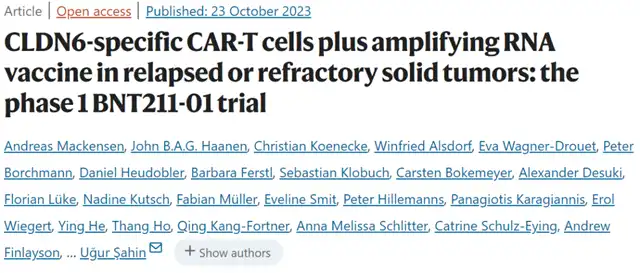Breakthrough in CAR-T Therapy for CLDN6-Positive Malignant Tumors
- Normal Liver Cells Found to Promote Cancer Metastasis to the Liver
- Nearly 80% Complete Remission: Breakthrough in ADC Anti-Tumor Treatment
- Vaccination Against Common Diseases May Prevent Dementia!
- New Alzheimer’s Disease (AD) Diagnosis and Staging Criteria
- Breakthrough in Alzheimer’s Disease: New Nasal Spray Halts Cognitive Decline by Targeting Toxic Protein
- Can the Tap Water at the Paris Olympics be Drunk Directly?
Breakthrough in CAR-T Therapy for CLDN6-Positive Malignant Tumors
- Should China be held legally responsible for the US’s $18 trillion COVID losses?
- CT Radiation Exposure Linked to Blood Cancer in Children and Adolescents
- FDA has mandated a top-level black box warning for all marketed CAR-T therapies
- Can people with high blood pressure eat peanuts?
- What is the difference between dopamine and dobutamine?
- How long can the patient live after heart stent surgery?
Breakthrough in CAR-T Therapy for CLDN6-Positive Malignant Tumors
“Nature Medicine”: Breakthrough in Solid Tumor CAR-T Therapy! Relief for Recurrent and Refractory Tumors.
CAR-T cell therapy has made significant strides in the clinical treatment of various blood cancers, but its use in solid tumors has faced numerous challenges. The complex tumor microenvironment and the barrier effect of tumor tissue have hindered CAR-T cells from directly contacting tumor cells, thus limiting their anti-tumor activity.
Recently, the prestigious medical journal “Nature Medicine” published the results of the dose-escalation phase of the BNT211-01 trial, bringing a significant breakthrough in solid tumor CAR-T therapy.

Previous research has suggested that the tight junction protein claudin 6 (CLDN6) may be an ideal immunotherapeutic target. The gene encoding CLDN6 protein is rarely expressed or nearly absent in healthy adult tissues but highly expressed in solid tumors, including ovarian cancer, lung cancer, endometrial cancer, and gastric cancer, among others.
BNT211 is a combination therapy consisting of a CAR-T therapy targeting CLDN6 and an RNA vaccine CARVac expressing the CLDN6 antigen. Its goal is to expand CLDN6-targeting CAR-T cells through multiple administrations of CARVac.
Researchers conducted a phase 1/2 “first-in-human” clinical trial called BNT211-01 to evaluate the safety and feasibility of CLDN6 CAR-T±CARVac treatment for CLDN6-positive recurrent and refractory solid tumors during the dose-escalation phase. The primary endpoints included the safety and tolerability of CLDN6 CAR-T±CARVac, the maximum tolerated dose for patients, and the recommended dose for the phase 2 trial. The secondary endpoints included the objective response rate (ORR) and disease control rate.
This paper reports the mid-term analysis data of 22 patients who received treatment with two doses of CLDN6 CAR-T (dose 1: 1×10^7; dose 2: 1×10^8)±CARVac in the dose-escalation part of the trial.
Statistical data show that among these 22 CLDN6-positive recurrent and refractory solid tumor patients (median age 46 years), 13 had germ cell tumors, 4 had epithelial ovarian cancer, 1 had endometrial cancer, 1 had fallopian tube serous carcinoma, 1 had desmoplastic small round cell tumor (DSRCT), 1 had gastric adenocarcinoma, and 1 had an unknown primary cancer.
These patients had a median of 4 prior lines of treatment (mostly platinum-based chemotherapy, with 3 patients having received immune checkpoint inhibitor therapy). Nearly half of the patients had lung metastases, and around 30% had liver involvement or peritoneal cancer. Importantly, the analysis results indicated the strongest expression of CLDN6 in patients with germ cell tumors and epithelial ovarian cancer.
Among these 22 patients, 20 received lymphodepletion before the infusion of CLDN6 CAR-T cells at dose 1 (n=7) or dose 2 (n=13), while 2 patients were at risk of long-term hematopoietic suppression and skipped lymphodepletion. Additionally, 4 patients and 7 patients who received dose 1 and dose 2 infusions, respectively, also received CARVac in combination therapy.
The analysis results from a median follow-up of 5 months (range: 29 days to 416 days) showed that patients receiving CLDN6 CAR-T±CARVac treatment had manageable safety features. Specifically, out of the 22 patients, 10 patients (46%) experienced cytokine release syndrome (including one grade 3 event), but 8 of these patients received dose 2 CLDN6 CAR-T cell infusions. One patient (5%) experienced grade 1 immune effector cell-associated neurotoxicity syndrome (ICANS).
At higher treatment doses (i.e., dose 2), 2 patients experienced dose-limiting toxicity, which resolved after treatment with no lasting effects, with one patient receiving CLDN6 CAR-T cell monotherapy and the other patient receiving combination therapy.
Overall, both dose levels of CLDN6 CAR-T monotherapy or combination therapy with CARVac were well-tolerated.
In terms of efficacy, among 21 evaluable patients, the ORR was 33% (7/21). This included 1 patient achieving complete remission and 6 patients achieving partial remission. Overall, the disease control rate for patients was 67% (14/21). Notably, patients with germ cell tumors who received higher-dose treatment exhibited the highest response rate, with an ORR of 57%.
Overall, the analysis results from this trial suggest that CLDN6 CAR-T, with or without CARVac, has promising clinical activity. The paper emphasizes that nearly half of the patients who received the higher dose of CAR-T cells (1×10^8) experienced objective remission, with 85% of patients achieving disease control.
The paper also highlights that one patient with a germ cell tumor achieved complete remission after a single infusion of 1×10^8 CLDN6 CAR-T cells (without CARVac or any further treatment), and this remission lasted for over a year. In summary, the analysis results indicate that CLDN6 CAR-T±CARVac therapy is feasible for CLDN6-positive malignant tumors, especially for those with rapidly progressing diseases or those who have previously received multiple ineffective treatments.
Reference:
[1] Mackensen, A., Haanen, J.B., Koenecke, C. et al. CLDN6-specific CAR-T cells plus amplifying RNA vaccine in relapsed or refractory solid tumors: the phase 1 BNT211-01 trial. Nat Med (2023). https://doi.org/10.1038/s41591-023-02612-0
Breakthrough in CAR-T Therapy for CLDN6-Positive Malignant Tumors
(source:internet, reference only)
Disclaimer of medicaltrend.org
Important Note: The information provided is for informational purposes only and should not be considered as medical advice.



